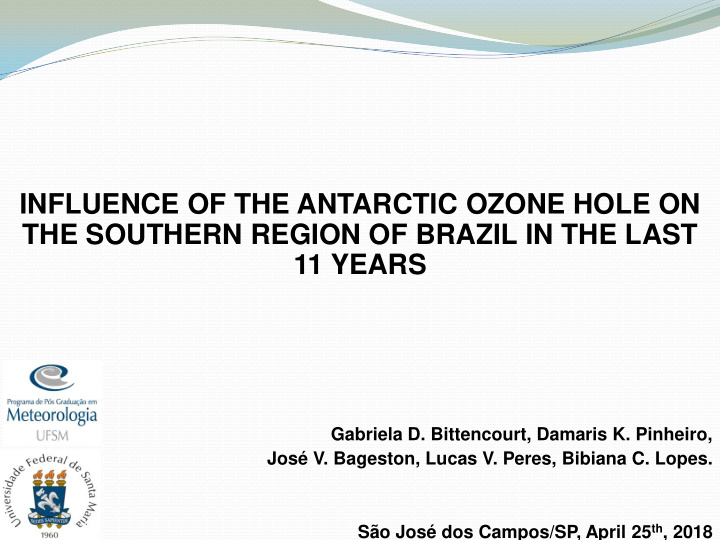



INFLUENCE OF THE ANTARCTIC OZONE HOLE ON THE SOUTHERN REGION OF BRAZIL IN THE LAST 11 YEARS Gabriela D. Bittencourt, Damaris K. Pinheiro, José V. Bageston, Lucas V. Peres, Bibiana C. Lopes. São José dos Campos/SP, April 25 th , 2018
INTRODUCTION Ozone is the main trace gas constituent of the stratosphere; Ozone Layer: Absorbs ultraviolet radiation (Salby, 1996 and Dobson, 1968); The Antarctic Ozone Hole (AOH) is a cyclical phenomenon that occurs during the spring and results in the temporary reduction of the total ozone content. Fonte: WMO, 2014.
INTRODUCTION The effects of this reduction in ozone content can influence mid- latitude regions in a phenomenon known as the Secondary Effect Event of the Antarctic Ozone Hole ’ (Kirchhoff et al., 1996) . The Potential Vorticity variable is widely used in these studies because it plays an important role in the dynamics of large-scale air masses (Hoskins et al., 1985). Fonte: https://ozoneaq.gsfc.nasa.gov/data/ozone/
OBJECTIVE The main objective of this work is to analyze the stratospheric and tropospheric dynamics during the occurrence of AOH influence events between 2006 and 2016.
METHODOLOGY The data used for the period from 2006 to 2016, comprising the Southern region of Brazil. Two instruments for ozone measurements: o Brewer MKIII Spectrophotometer # 167, installed in São Martinho da Serra / RS. o OMI Satellite (Ozone Monitoring Instrument), available on NASA's website . Reanalysis Data (ECMWF) - Interim Daily. IDENTIFICATION OF THE SECONDARY EFFECT EVENT OF AOH Analysis of the average daily ozone data; The average daily value of the total ozone column should be less than the climatological average of the month - 1.5 of its standard deviation (μ - 1,5σ);
METHODOLOGY Selected the days of possible occurrence of the event; Stratospheric analysis corresponds to the fields at different levels of potential temperature; The analysis of the tropospheric dynamics was done through meteorological fields in high and medium atmospheric and surface levels.
RESULTS 11 years of data analyzed through surface and satellite instruments; We identified 34 events of influence of the AOH that reached the southern region of Brazil; In total, 4015 days were available for analysis; Of this total, 86 days had a value lower than the climatological average - 1.5 of their standard deviation; The 86 days, 34 were characterized as events of secondary effect of the AOH on the southern region of Brazil;
EVENT DAY OCTOBER 20, 2016 The event of 10/20/2016 was the second most intense event ever recorded in the last 25 years (BITTENCOURT et al., 2018); The Brewer Spectrophotometer recorded for the 10/20/16 a value of 225 DU on the region; o The area of the AOH is defined as a region with values less than 220 UD (Hofmann et al., 1997). Reduction of ~ 21% of the total ozone content, in relation to the climatological average on October;
EVENT DAY OCTOBER 20, 2016
EVENT DAY OCTOBER 20, 2016 Level 700 K Potential Vorticity 700 K (10/19/2016) Potential Vorticity 700 K (10/20/2016) Potential Vorticity 700 K (10/21/2016)
EVENT DAY OCTOBER 20, 2016 ANALYSIS OF TROPOSPHERIC DYNAMICS
EVENT DAY OCTOBER 20, 2016 On the surface, the arrival of a high-pressure system helps to stabilize the atmosphere, and the intrusion of the mass of O 3.
EVENT DAY OCTOBER 20, 2016 Presence of the subtropical jet stream and center with negative values of Omega;
EVENT DAY OCTOBER 20, 2016 Presence of the subtropical jet stream, at higher levels;
STATISTICAL ANALYSIS During the 11 years of analysis: 17.6% occurred in August (6 events); 32% in September (11 events); 38% in October (13 events); 11.7% in the month of November (4 events) In relation to the presence of the subtropical and / or polar jet stream, we have: o of the 34 events, in 91% of the cases the jet stream was present; In 68% of cases, the event occurred after the passage of a frontal system over the study region;
CLIMATOLOGY Potential Vorticity Climatology - August (2006 – 2016) 700 K Potential Vorticity Climatology - September (2006 – 2016) 700 K Potential Vorticity Climatology - October (2006 – 2016) 700 K Potential Vorticity Climatology – November (2006 – 2016) 700 K For the fields of climatology from August to September, it is observed: increase of APV in the months of August and September, close to 65º S;
CLIMATOLOGY Potential Vorticity Climatology - August (2006 – 2016) 700 K Potential Vorticity Climatology - September (2006 – 2016) 700 K In the months of October and November the opposite is observed, a decrease in VPA over the region; Potential Vorticity Climatology - October (2006 – 2016) 700 K Potential Vorticity Climatology – November (2006 – 2016) 700 K
ANOMALY Anomaly August (2006 – 2016) Anomaly September (2006 – 2016) Anomaly October(2006 – 2016) Anomaly November (2006 – 2016)
ANOMALY Anomaly August (2006 – 2016) Anomaly September (2006 – 2016) For the anomaly analyzes, the predominance of positive anomalies is observed, mainly for the months of September and October. o months with greater occurrence of events for the period analyzed; Anomaly October(2006 – 2016) Anomaly November (2006 – 2016)
MEDIUM HORIZONTAL FIELD OF EVENTS MEDIUM FIELD 34 EVENTS (2006 - 2016) Jet 250 mb SUBTROPICAL JET
CONCLUSIONS We identified 34 events of influence of the AOH on the Southern region of Brazil for the period of 11 years of data; The climatology of the stratospheric fields presented a increase of APV in the months of August and September; Prevalence of positive anomalies for the months of analysis, mainly in September and October over the study region; Of the 34 cases, 91% confirmed the presence of the jet stream, and 68% after the passage of frontal systems;
Recommend
More recommend